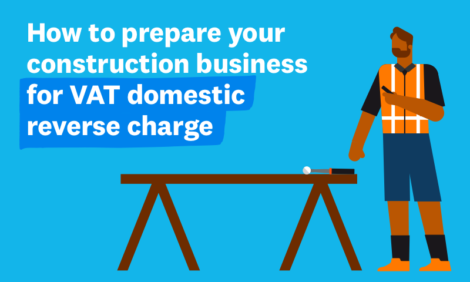
How to prepare your business for the VAT domestic reverse charge

The VAT domestic reverse charge procedure is a new way of accounting for VAT in the construction industry. It is due to come into effect in the UK on 1 March 2021, having previously been delayed from 2019 and then October 2020 by HMRC.
If your business is affected here’s how you can prepare and apply the upcoming changes in Xero.
Ensure your software is up to date
If you use accounting software you’ll need to check it will deal with the new VAT domestic reverse charge. For example, if you are using desktop software, you will need to check with your supplier if a manual update is available.
If you already use Xero, you’re all set because – our product has already been updated to help you comply with DRC.
If you don’t currently use software for your business then this is a great time to start. Using cloud accounting software like Xero makes life a whole lot simpler especially when dealing with CIS and VAT.
Consider your cash flow
Consider whether the change will impact your cash flow. If you are a subcontractor then it’s likely your cash flow will be impacted as you will no longer be receiving the VAT payment from your customer. If you are the contractor, you will likely have a short term cash flow benefit as you will no longer be paying the VAT amount to the subcontractor, however you must remember you will need to account for VAT as output tax (box 1) as well as input tax (box 4), along with the rest of your VAT accounting. Remember to reach out to your accountant who will be able to help should you need it.
Communicate with your staff, contractors and/or customers
Make sure all of your staff who are responsible for VAT accounting are aware of the reverse charge and how it will work. If you are a contractor you should also be proactive in contacting your VAT-registered subcontractors prior to the 1 March 2021 to ensure they are aware of these changes and don’t invoice you for VAT. Likewise, if you are a subcontractor be sure to contact your contractor customers to make them aware you will be applying the domestic reverse charge to invoices from 1 March 2021.
How to activate the VAT domestic reverse charge in Xero
Whether you are a subcontractor or contractor, Xero calculates the domestic reverse charge automatically – so the hard work is done for you.
To do this, we have added new VAT rates for domestic reverse charge in Xero. They need to be ‘switched’ on before they can be used. To do this simply select the ‘Add Domestic Reverse Charge Rates’ within the Tax Rates function in Advanced Accounting in Xero. This is shown below:

When you select the button you will get the option of adding the following tax rates:

Key VAT domestic reverse charge features
If you are a subcontractor you need to use the ‘Domestic Reverse Charge on Income’ tax rates when raising invoices for construction services and related supplies. Xero will know that VAT should not be charged and will inform your customer that they are to account for VAT. If you are using Xero’s CIS feature it will also automatically calculate the CIS your supplier should withhold. Here is an example invoice:

If you are a contractor you need to use the ‘Domestic Reverse Charge on expense’ tax rates when entering bills for construction services and related supplies. Xero will know that reverse charge is to be applied and will automatically ensure the correct VAT boxes are updated on the VAT return. If you are using the CIS feature Xero will also calculate the amount of CIS to withhold. Here’s an example:

Resources
- To find out more about how the DRC works in Xero read our Xero Central guide.
- To see a live Xero demo, join our CIS and domestic reverse charge webinar.
- For more information on the DRC for the building and construction industry read HMRC’s notice or watch their webinars.
- If you’re not yet a customer, you can sign up for a free trial and see how the VAT domestic reverse charge works in Xero.
The post How to prepare your business for the VAT domestic reverse charge appeared first on Xero Blog.
Source: Xero Blog






